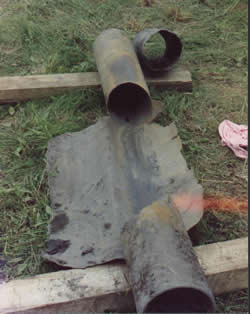|

_______________
BY TOM KEYSER
Freelance Columnist
_______________ |
|
Member Patrick Teevens, P.Eng., Tells PM That Pipeline Corrosion
Needs Attention
During a visit to Calgary last October, Prime Minister Paul
Martin got the low-down on the impact and dangers of corrosion.
The PM listened politely, acknowledged his lack of awareness
and familiarity of the subject and pledged he’d investigate.
The source of the prime minister’s introduction to
corrosion was Patrick Teevens, CD, P.Eng. As Mr. Teevens
sees it, he was simply doing his duty when he buttonholed
the new Liberal prime minister during a tour of his Calgary
office building at the Alastair Ross Technology Centre.
Indeed, the NACE International, certified specialist in corrosion
engineering and the president of Broadsword Corrosion Engineering
Ltd. approaches the subject, with a high level of professionalism
and uncompromising sense of duty to the public well-being.
"As long as we all do our jobs properly, nothing happens," says
Mr. Teevens.
 |
Corrosive Behaviour
This pipe ruptured because of CO2 |
Things Happen
But things do happen, virtually every day. His company can
help, both before problems occur and afterwards. Broadsword
gauges pipeline conditions and designs corrosion abatement
strategies on behalf of energy industry clients.
More than 300,000 kilometres of pipeline criss-cross the
province and many more are on the way, pending approvals
of the Mackenzie Valley natural gas pipeline. That puts Mr.
Teevens and his company in the catbird seat of a growth industry.
On average, Alberta pipelines fail, with varying degrees
of severity, 700 to 800 times a year. Statistics indicate
that more than half these failures result from internal corrosion.
Mr. Teevens describes the frequency of failures as a "concern," taking
considerable care not to sprinkle his conversation with any
alarmist terms such as "crisis."
On the contrary, he praises Alberta oil and gas production
and transmission companies for improving their standards
of vigilance and maintenance in recent years. He also applauds
the Alberta Energy and Utilities Board for reasonably strict
enforcement of its pipeline maintenance guidelines.
"In fact, the EUB is probably one of the more progressive
regulatory agencies in North America, especially in terms
of keeping statistics on provincial pipelines," he says.
Nevertheless, corrosion remains a significant – and
expensive – problem for the industry at large.
And it doesn't stop with oil and gas. In fact, oil and gas
upstream production operations account for a small fraction
of the total cost of corrosion to the overall economy.
U.S. Report is Telling
The U.S. Department of Transportation, Federal Highways Administration,
has reported that corrosion costs American industry a minimum
of $276 billion US (2001 dollars) a year, equivalent to
about three per cent of the country’s GDP, Mr. Teevens
points out.
Meanwhile, the U.S. military says that corrosion of infrastructure
and equipment costs the government an estimated $20 billion
US annually, while adversely affecting operational readiness.
On the bright side, researchers also believe that proactive,
best-practice engineering procedures can do much to mitigate
this awesome expense.
"The authors of the U.S. report feel that 40 per cent
of the corrosion problem is preventable," says Mr. Teevens,
who's convinced that corrosion detection and prevention techniques
can also save Canadian petroleum production and transmission
companies a bundle.
However, he worries some companies may be unwittingly placing
themselves at risk by not availing themselves of NACE International
certified people to maintain and operate their corrosion
mitigation programs for their pipelines. Well-trained, base-competency,
certified corrosion engineers and technologists can serve
their employers by properly maintaining and monitoring pipelines.
Stricter Standards Needed
Mr. Teevens says there's a pressing and emerging need for
stricter corrosion base-competency standards, right across
Canada.
"The big question is, who are the people managing these
pipelines in our country?” he says. "In the U.S., the decision-makers
must be educated and trained to certain standards."
Meanwhile, software developers across North America are running
a high-stakes sweepstakes to be first to come up with an
intelligent, internal corrosion prediction tool that will
predict corrosion behaviour within multiphase pipelines.
Not surprisingly, Mr. Teeven’s company, Broadsword,
has entered its own dark horse in this race. It's called
enpICDA™, a coined term that describes a technically
advanced, engineering predictive model for the internal corrosion
direct assessment of flowing pipeline systems. It's been
on the market since last year.
"From a chemical engineering perspective, enpICDA looks
at fluid hydrodynamics, heat transfer and mass transfer (mass
transport) of key specific contributing or dominant ions
involved in the corrosion process, to and from the inside
pipeline wall," explains Mr. Teevens.
By relying on enpICDA and other strategies, Broadsword builds
corrosion management plans that allow clients to comply with
EUB guidelines. Business is brisk, although Mr. Teevens says
some companies are “painfully” slow to recognize
that a proactive response to pipeline corrosion can actually
save them cash, paying huge financial and corporate image
dividends in the long run. That’s something hard to
portray, he says, when “long-term” visions of
corporations are actually short-term.
"By maintaining pipeline integrity, we eliminate lost
production and costly down time," Mr. Teevens concludes. "And
we keep people safe."
|




